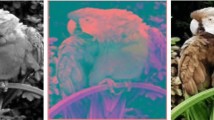Abstract
Colour images tend to be more visually appealing to humans compared to grayscale images, as colour images are closer in representation to the natural way we perceive our environment. While obtaining grayscale images from colour images is relatively trivial, the reverse process is not. In this paper, a machine learning method inspired by the Bayer filter and the demosaicing process of digital colour cameras, is proposed for the colourisation of grayscale images. The method involves training a multilayer perceptron model on colour images that are semantically similar to each other. The model can, henceforth, colourise grayscale images that are semantically similar to those in the training set. The success of our method is dependent on an image data representation model developed for this purpose. The proposed model gives impressive results despite requiring no human intervention and less machine resources for training when compared with existing deep learning models.
Access this chapter
Tax calculation will be finalised at checkout
Purchases are for personal use only
Similar content being viewed by others
References
Gupta, R.K., Chia, A.Y.-S., Rajan, D., Ng, E.S., Zhiyong, H.: Image colorization using similar images. Clemson University, Clemson, South Carolina (2012)
Gustav, L., Michael, M., & Gregory, S. (2016). Learning Representations for Automatic Colorization. European Conference on Computer Vision (pp. 577–593). Chicago: Springer
Halder, S. S., Kanjar, D., & Roy, P. P. (2018). Perceptual Conditional Generative AdversarialNetworks for End-to-End Image Colourization. Asian Conference on Computer Vision (pp. 269–283). Springer. https://doi.org/10.1007/978-3-030-20890-5_18
Jiahao, P., Oscar, C. A., Ketan, T., & Yuanfang, G. (2013). Image colorization using sparse representation. International Conference on Acoustics, Speech, and Signal Processing, 1988 (pp. 1578–1582). IEEE. https://doi.org/10.1109/ICASSP.2013.6637917
Johannes, P., Fabian, P., & Gabriele, S. (2017, October 31). Exemplar-based face colorization usingImage morphing. J. Imaging, 3(48). https://doi.org/10.3390/jimaging3040048
Khan, M. U., Gotoh, Y., & Nida, N. (2017). Medical Image Colorizationfor Better Visualization and Segmentation. In H. M. Valdés, & V. González-Castro (Ed.), Medical Image Understanding and Analysis (pp. 571–580). Edinburgh: Springer. https://doi.org/10.1007/978-3-319-60964-5_50
Kumar, A., Agarwal, T.: Automatic Colorization of Grayscale Image. Indian Institute of Technology Kanpur, Kanpur, India (2014)
Levin, A., Lischinski, D., & Weiss, Y. (2004). Colorization using optimization. ACM Transactions on Graphics (TOG) (pp. 689–694). Los Angeles, California: ACM
Liu, B. B., & Lu, Z. M. (2009). Image colourisation using graph-based semi-supervised learning. IET Image Processing, 115-120
Marc, G. B., Issa, K., Alan, S., Noel, O., & Marta, M. (2021). Attention-based Stylisation for Exemplar Image Colourisation. London: arXiv
Nazeri, K., Ng, E., & Ebrahimi, M. (2018). Image Colorization Using Generative Adversarial Networks. International Conference on Articulated Motion and Deformable Objects. 10945, pp. 85–94. Springer, Cham. https://doi.org/10.1007/978-3-319-94544-6_9
Rita, P., Christian, M., Gian, L. F., & Niki, M. (2020). Is It a Plausible Colour? UCapsNet for Image Colourisation. 34th Conference on Neural Information Processing Systems. Vancouver: arXiv
Sykora, D., Burianek, J., & Zara, J. (2005). Colorization of black-and-white cartoons. 3rd international symposium on Non-photorealistic animation and rendering (pp. 121–127). Annecy, France: ACM
Welsh, T., Ashikhmin, M., & Mueller, K. (2002). Transferring color to greyscale images. ACM Trans. Graph (SIGGRAPH 2002) 21, 3, 277-280
Yuji, M., Yuichi, T., & Naemura, T. (2009). Automatic colorization of grayscale images using multiple images on the Web. Special Interest Group on Computer Graphics and Interactive Techniques Conference (SIGGRAPH). Louisiana, New Orleans: Association for Computing Machinery
Author information
Authors and Affiliations
Corresponding author
Editor information
Editors and Affiliations
Rights and permissions
Copyright information
© 2023 The Author(s), under exclusive license to Springer Nature Switzerland AG
About this paper
Cite this paper
Shokunbi, O.M., Akinyemi, J.D., Onifade, O.F.W. (2023). A Deep Multi-Layer Perceptron Model for Automatic Colourisation of Digital Grayscale Images. In: Chmielewski, L.J., Orłowski, A. (eds) Computer Vision and Graphics. ICCVG 2022. Lecture Notes in Networks and Systems, vol 598. Springer, Cham. https://doi.org/10.1007/978-3-031-22025-8_14
Download citation
DOI: https://doi.org/10.1007/978-3-031-22025-8_14
Published:
Publisher Name: Springer, Cham
Print ISBN: 978-3-031-22024-1
Online ISBN: 978-3-031-22025-8
eBook Packages: Intelligent Technologies and RoboticsIntelligent Technologies and Robotics (R0)




